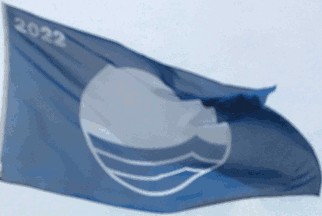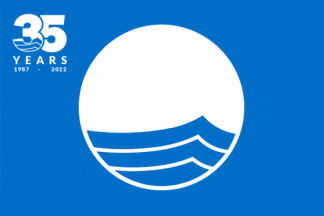 zachary harden
zachary harden
Keywords: blue flag | beach quality | fee | feee |
Links: FOTW homepage | search | disclaimer and copyright | write us | mirrors

Last modified: 2023-11-25 by  zachary harden
zachary harden
Keywords: blue flag | beach quality | fee | feee |
Links: FOTW homepage |
search |
disclaimer and copyright |
write us |
mirrors
Other sites:
The Foundation for Environmental Education (FEE) is a non-profit,
non-governmental organisation consisting of Member organisations representing 25
European countries.
The program of the European Blue Flag has been working since 15 years.
The countries participating to the program are:
Belgium | Bulgaria | Croatia | Cyprus | Denmark | Estonia | Finland | France | Germany | Greece | Ireland | Italy | Latvia | Lithuania | Netherlands | Norway | Portugal | Slovenia | South Africa | Spain | Sweden | Turkey | United Kingdom
More than 2,400 beaches and marinas are now participating in the programme.
Iceland, Romania,
Morocco, Montenegro
and the Caribbean are working on establishing the Blue Flag Campaign.
Santiago Tazon & Jan Mertens, 19 June 2003
A
booklet published the Blue Flag Organization says that the "Blue Flag
campaign started in Europe in 1987 with the purpose of encouraging beaches to
comply with the EU Bathing Water Directive", and that the project has developed
ever since, and as of 2005 the Foundation for Environmental Education, the
campaign's managing organization, includes members in 38 countries and an
International Jury with representatives of:
United Nations Environment Program (UNEP)
World Tourism Organization (UNWTO)
International Lifesaving Federation (ILS)
International Council of Marine Industry Associations (ICOMIA)
World Conservation Union (IUCN)
European Union for coastal Conservation (EUCC)
Environmental Education Expert
It is a "symbol of quality recognized by tourists and tour operators", and
therefore it is not a signal flag, but an award flag. Still according to the
booklet, as "of 2006 there were over 3200 sites awarded with the Blue
Flag in 36 countries including countries in Europe, countries in the Caribbean,
Morocco, New Zealand, Canada and South Africa."
A previous edition stated that as "of 2005
there were over 3000 sites awarded with the Blue Flag in 33 countries including
26 countries in Europe, countries in the Caribbean, Morocco, Canada and South
Africa". However, at
http://www.fee-international.org/Programmes/blueflag, it says that the Blue
Flag was "awarded in 2007 to more than 3200 beaches and marinas in 37
countries across Europe, Morocco, South Africa, Canada, New Zealand and the
Caribbean". Note removal and re-addition of New Zealand; cf.
http://www.blueflag.org.nz/.
The criteria for awarding the Blue Flag are updated yearly, "designed to work
with the relevant national, regional and local legislation of each country", and
have been "adapted and expanded to encompass issues encountered in areas outside
of Europe", covering issues of beach and marina "environmental information and
education, water quality, safety and services and environmental management",
says the
booklet. Some of these criteria, namely those concerning safety and area
uses, may concern the use of signal flags, but the
booklet does not expressly mentions that aspect. In countries or regions
with where beach safety regulations prescribe flag usage, then the Blue Flag can
only be awarded to beaches using them accordingly.
According to the booklet, candidate beach and marinas that "have been accepted
by the International Jury are awarded with the Blue Flag for one season". These
candidates are pre-reviewed by each national jury yearly; the International Jury
meets twice a year to review applications from different areas of the world.
The
booklet also states that "Control visits are made during the Blue Flag
season by both national and international controllers to assure that all
criteria are being met. If problems are found the flag is withdrawn until they
are fixed. If the problem is very serious or if the problem is not fixed within
a given period of time then the flag is withdrawn for the rest of the season."
António Martins, 12 September 2007
The FEE just e-mailed me to tell that the Blue Flag is not limited to marine
sites. Sites at lakes and rivers are awarded as well, but with the limitation
already mentioned: they have to apply for it themselves.
Peter Hans van den Muijzenberg, 18 September 2007
As that's the same year as the specimen in Sneek, which has just a
single year, I asked why Water-sports Zwartsluis (in Zwartsluis) had a double year version, and they told
me: This is because they are open all year.
Of course, this is not yet the whole story, so I'll try to get more
information from the FEE. I expect quite a few town/city harbours in The
Netherlands are open all year, simply because nobody ever came up with
the idea to lock them down. Yet, I think this is the first time I see a
double year version in The Netherlands, so there must be more to it.
If I learn more about it, I'll let you know. In the mean time, the
Zwartsluis version is a clear indication of the size of the flag. (I
know the size, but from my photographs it's not all that visible that
the flag is human-sized.)
Peter Hans van den Muijzenberg, 3 June 2023
The Blue Flag is awarded by the Foundation for Environmental Education in
Europe (FEEE).
The Blue Flag is a widely recognised eco-label. This is awarded to beaches and
marinas where environmental protection is a high priority in site management and
information encourages care for the environment.
The award of the Blue Flag is presently based on 27 specific criteria for
beaches and 16 specific criteria for marinas. Though the specific requirements
are different for the two types of sites, they cover the same four aspects:
Some criteria are imperative whereas other are guideline criteria.
All Blue Flags are only awarded for one season at a time. By renewing the
award each season the Campaign ensures that the beaches and marinas are
constantly living up to the criteria. If some of the imperative criteria are not
fulfilled during the season or the conditions change, the Blue Flag will be
withdrawn.
Pascal Gross, 14 August 2000
Note that the flag, as the example shown on the top of this page (after a
picture published in 20 Minutes, French edition, on 12 May 2002) should
have inscribed in white characters in the canton the year for which it was
granted and in the lower hoist the acronym Feee [or Fee] and copyright sign. That is
because the flag is granted for one year only, and the next year the competition
starts anew.
In Croatia the year is written with a dot after the year (e.g. 2002.),
which is the grammatical proper form in Croatian.
Only the flags that are really hoisted on the beaches and other appropriate
sites contain the year and acronym. Small table flags seen in hotel receptions
and such places, as well as most of the promotional posters explaining the flag,
do not contain those numbers/acronym.
Željko Heimer, 22 May 2002
The Foundation for Environmental Education in Europe morphed into the
Foundation for Environmental Education in order to accommodate non-European
countries. The abbreviation therefore has reduced to Fee on the flag.
Ivan Sache, 30 May 2005
![[1989 Blue Flag]](../images/i/int-bf89.gif) image
by Jorge Candeias, 24 March 2006
image
by Jorge Candeias, 24 March 2006
An earlier version of the FEEE
beach quality blue flag. The Público newspaper published in July 29, 2003
an archive photo of one of these flags
flying. The photo shows what appears to be the reverse side of the flag. The
numbers are mirrored, the logo is just as mirrored, etc. I wouldn't be so sure,
however: the photo could have been mirrored to fit better in the design of that
newspaper page. Anyway, this pretty much confirms my memory: the circle of stars
is there, the numbers are very much like the ones I drew. The colour is still
uncertain, though, since this photo is black and white, and the stars are
upright.
Jorge Candeias, 14 November 2005, 24 March 2006
I can confirm the existence of this flag with a "2007" on
it.
Peter Hans van den Muijzenberg, 11 September 2007
 picture taken by Peter Hans van den Muijzenberg, 26 June 2022
picture taken by Peter Hans van den Muijzenberg, 26 June 2022
An even more recent version of the Blue Flag, the text "FEE" and the copyright symbol have been removed from the bottom left of the flag.
The bottom left text has been removed from flags (at least)
since
2010.
Peter Hans van den Muijzenberg, 26 June 2022 and Zachary Harden, 03 July 2022
![[1989 Blue Flag pennant]](../images/i/int-bpe.gif) image
by Jorge Candeias and António Martins-Tuválkin, 18 September 2007
image
by Jorge Candeias and António Martins-Tuválkin, 18 September 2007
Starting 2003, individual boat owners can earn a Blue Pennant. First in
Belgium is Ms. Elisabeth Lemmens of the Antwerp
Willemdok yacht harbour. I saw this pennant very briefly on TV news. A Blue Flag
costs 125 euros whereas a Blue Pennant costs 8 euros.
Jan Mertens, 19 June 2003
Unlike the "real" FEE Blue Flag, this is not an award, as the boats using
it do not need to present an application and wait for a national, then
international, jury decision, nor are they subject to reviews or control
visits. If one wants a flag for one's boat, one just buys it.
Upon buying the Blue Flag for individual boat owners, one must sign a code
of conduct that covers the same kind of safety and environmental concerns as
the beach/marina flag award (things like not throwing garbage into the sea,
etc.). The booklet doesn't say what happens if a violation of the
code of conduct is reported or witnessed.
António Martins, 18 September 2007
 image
located by Zachary Harden, 03 July 2022
image
located by Zachary Harden, 03 July 2022
In
an article by The Irish Examiner, there is a young man holding this special flag to honor the 35th anniversary of the Blue Flag project on one of the awarded beaches in Ireland. It is the main blue flag, with the anniversary logo at the top left hoist.
Zachary Harden, 03 July 2022